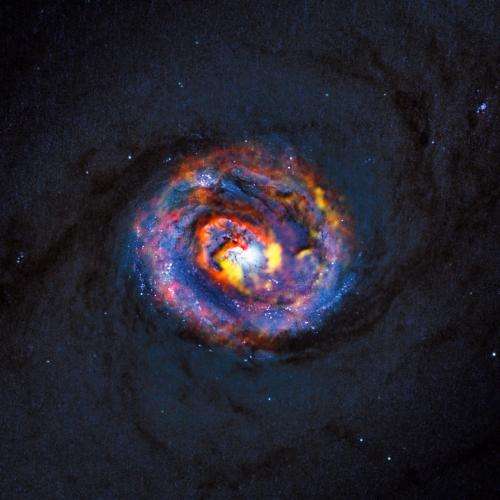ALMA probes mysteries of jets from giant black holes

Two international teams of astronomers have used the power of the Atacama Large Millimeter/submillimeter Array to focus on jets from the huge black holes at the centers of galaxies and observe how they affect their surroundings. They have respectively obtained the best view yet of the molecular gas around a nearby, quiet black hole and caught an unexpected glimpse of the base of a powerful jet close to a distant black hole.
There are supermassive black holes—with masses up to several billion solar masses—at the hearts of almost all galaxies in the Universe, including our own galaxy, the Milky Way. In the remote past, these bizarre objects were very active, swallowing enormous quantities of matter from their surroundings, shining with dazzling brilliance, and expelling tiny fractions of this matter through extremely powerful jets. In the current Universe, most supermassive black holes are much less active than they were in their youth, but the interplay between jets and their surroundings is still shaping galaxy evolution.
Two new studies, both published today in the journal Astronomy & Astrophysics, used ALMA to probe black hole jets at very different scales: a nearby and relatively quiet black hole in the galaxy NGC 1433 and a very distant and active object called PKS 1830-211.
"ALMA has revealed a surprising spiral structure in the molecular gas close to the centre of NGC 1433," says Françoise Combes (Observatoire de Paris, France), who is the lead author of the first paper. "This explains how the material is flowing in to fuel the black hole. With the sharp new observations from ALMA, we have discovered a jet of material flowing away from the black hole, extending for only 150 light-years. This is the smallest such molecular outflow ever observed in an external galaxy."
The discovery of this outflow, which is being dragged along by the jet from the central black hole, shows how such jets can stop star formation and regulate the growth of the central bulges of galaxies.
In PKS 1830-211, Ivan Marti-Vidal (Chalmers University of Technology, Onsala Space Observatory, Onsala, Sweden) and his team also observed a supermassive black hole with a jet, but a much brighter and more active one in the early Universe. It is unusual because its brilliant light passes a massive intervening galaxy on its way to Earth, and is split into two images by gravitational lensing.
From time to time, supermassive black holes suddenly swallow a huge amount of mass, which increases the power of the jet and boosts the radiation up to the very highest energies. And now ALMA has, by chance, caught one of these events as it happens in PKS 1830-211.
"The ALMA observation of this case of black hole indigestion has been completely serendipitous. We were observing PKS 1830-211 for another purpose, and then we spotted subtle changes of colour and intensity among the images of the gravitational lens. A very careful look at this unexpected behaviour led us to the conclusion that we were observing, just by a very lucky chance, right at the time when fresh new matter entered into the jet base of the black hole," says Sebastien Muller, a co author of the second paper.
The team also looked to see whether this violent event had been picked up with other telescopes and were surprised to find a very clear signal in gamma rays, thanks to monitoring observations with NASA's Fermi Gamma-ray Space Telescope. The process that caused the increase of radiation at ALMA's long wavelengths was also responsible of boosting the light in the jet dramatically, up to the highest energies in the Universe.
"This is the first time that such a clear connection between gamma rays and submillimetre radio waves has been established as coming from the real base of a black hole's jet," adds Sebastien Muller.
The two new observations are just the start of ALMA's investigations into the workings of jets from supermassive black holes, near and far. Combes's team is already studying other nearby active galaxies with ALMA and the unique object PKS 1830-211 is expected to be the focus of much future research with ALMA and other telescopes.
"There is still a lot to be learned about how black holes can create these huge energetic jets of matter and radiation," concludes Ivan Marti-Vidal. "But the new results, obtained even before ALMA was completed, show that it is a uniquely powerful tool for probing these jets—and the discoveries are just beginning!"
More information: These research projects are presented in two papers, "ALMA observations of feeding and feedback in nearby Seyfert galaxies: an AGN-driven outflow in NGC1433", by F. Combes et al. and "Probing the jet base of the blazar PKS 1830−211 from the chromatic variability of its lensed images: Serendipitous ALMA observations of a strong gamma-ray flare", by I. Marti-Vidal et al. Both papers are appeared in the journal Astronomy & Astrophysics.
Journal information: Astronomy & Astrophysics
Provided by ESO



















